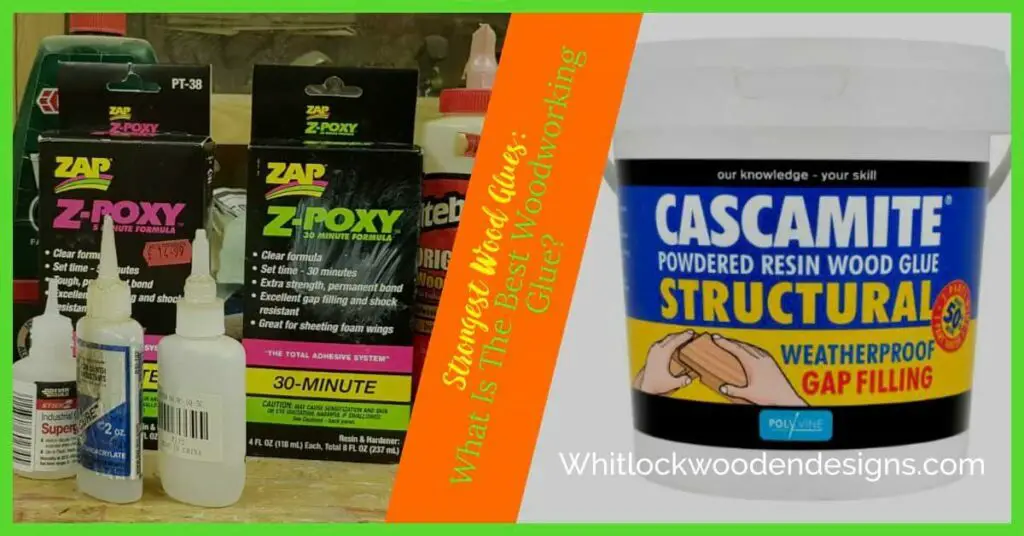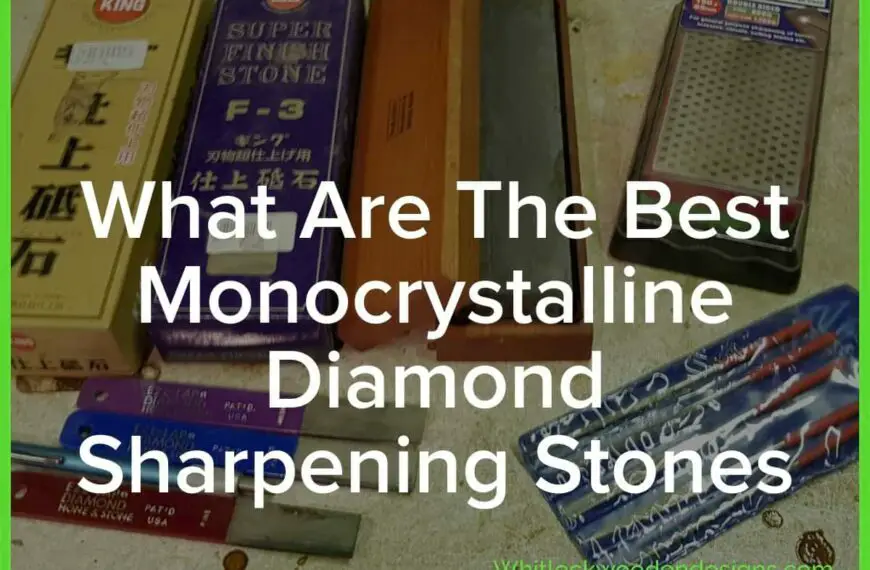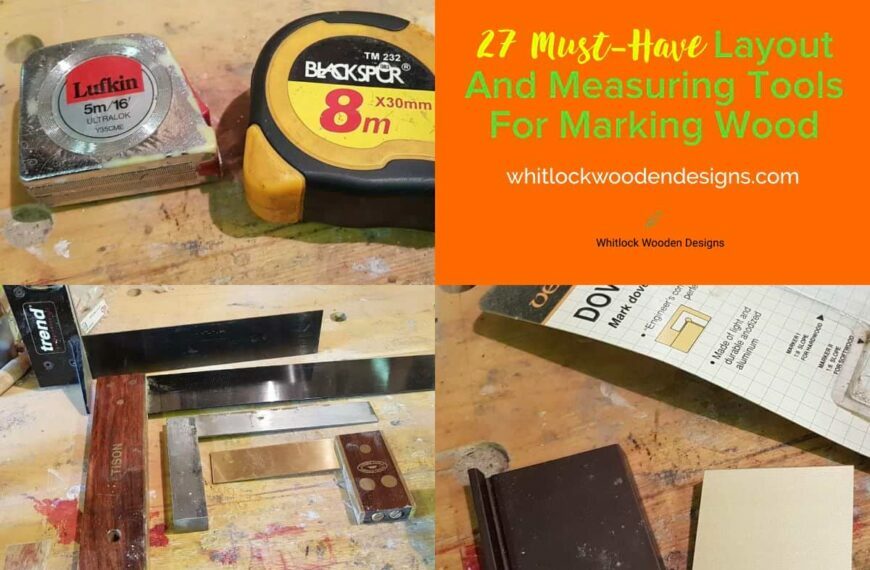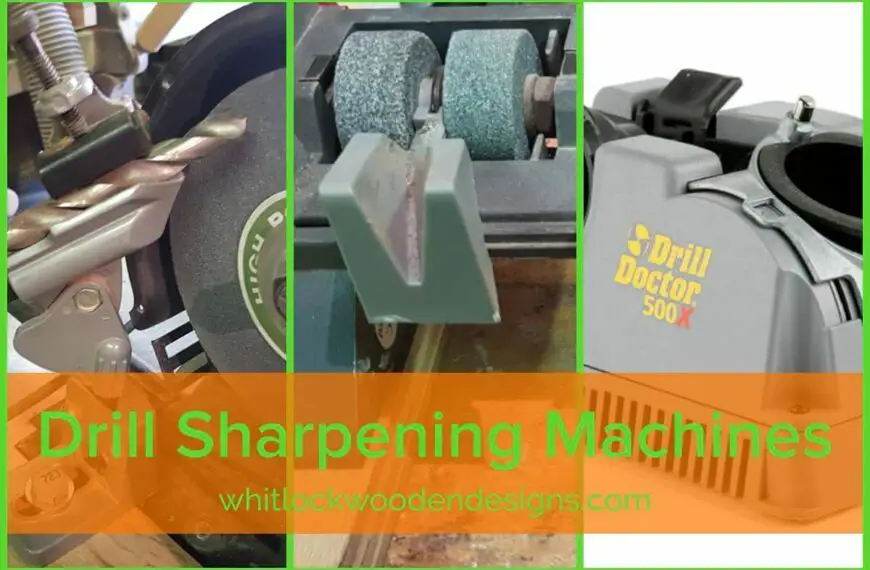Woodworking glue is a crucial tool for any woodworker, whether you are a beginner or a seasoned pro. It is used to join two pieces of wood together, creating a strong, lasting bond. There are many different types of glue on the market, with specific characteristics and uses. This article will discuss the strongest and best wood glues to help you decide the best option for your needs.
What is the strongest wood glue available?
One of the strongest types of wood glue for your project is epoxy-based glue. It is a two-part system that is extremely strong and durable. It is impervious and suitable for a variety of surfaces.
In reality, it may not be the most suitable; they are all strong if used for what was intended. You don’t have to be a chemical physicist, but you should know the characteristics to benefit from them. When it comes to outside applications, the strongest glue is one that will provide the best results.
Many factors affect glue strength: grain orientation, filling cracks, and outside exposure. Lightweight, cheap wood may require different glue to a dense tropical sort, so choose a glue for your wood.
The second is the type of glue best for wood itself. Titebond II PVA wood glue is the most recommended glue for general use. It has a high tensile strength with an assortment of materials. Follow the manufacturer’s instructions to avoid weak or ineffective joints.
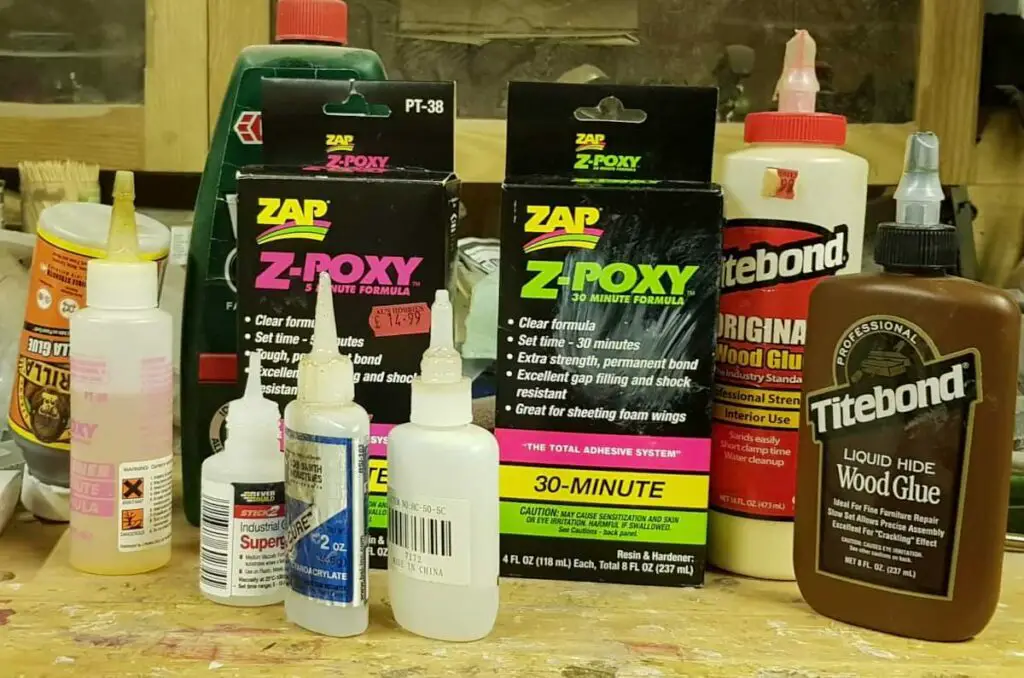
What are the eight different types of wood glue?
There are many different types of glues in the marketplace, but not all deliver the same results. In this section, we will go over the eight basic formulas.
- Polyvinyl Acetate (PVA)
- Animal Glue
- Urea-Formaldehyde (UF)
- Melamine-Formaldehyde (MF)
- Phenol-Formaldehyde (PF)
- Polyurethane (PU)
- Cyanoacrylate (CA)
- Epoxy
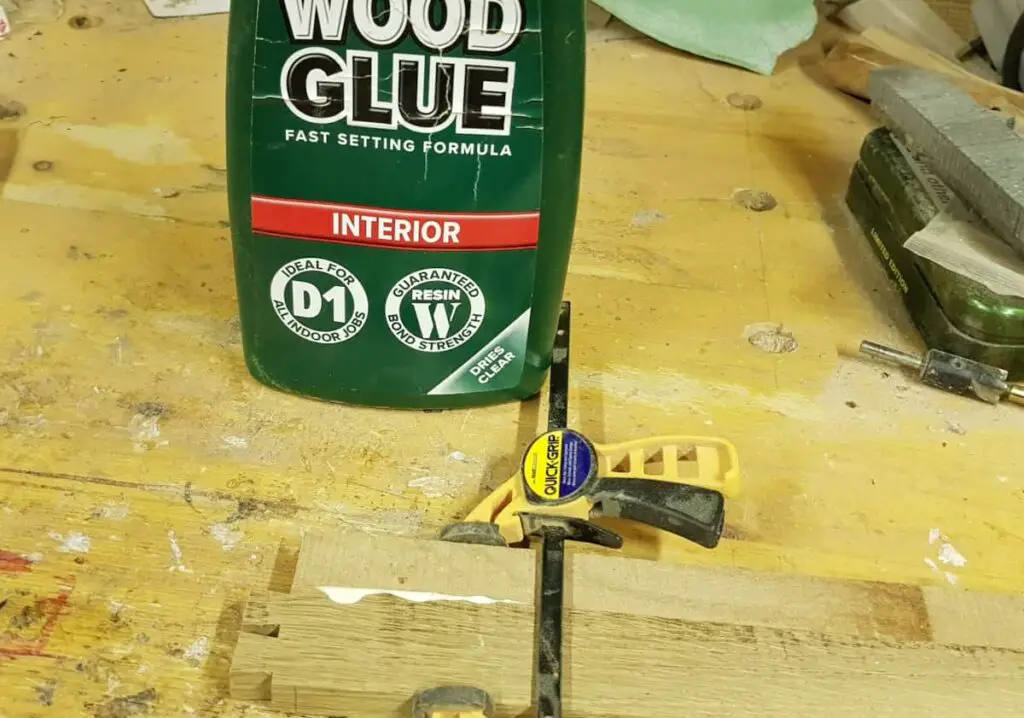
Polyvinyl Acetate Glue (PVA)
It is a rubbery synthetic polymer adhesive for woodwork that forms a flexible, permanent bond when dry. PVA glue is easy to clean, nontoxic, water-soluble, colorless, and odorless. It’s available in white and yellow. This common glue can be used to bond wood, paper, fabric, and leather. Every artisan has a bottle of wood glue on their bench.
The most commonly used wood glue in the world is PVA. For big or small tasks in the house or site work, it is robust and sets best in well-ventilated spaces. Regular PVA is not a waterproof glue, so it is unsuitable for food or drink utensils. Cross-linking polyvinyl acetate makes Titebond-II more water-resistant than normal PVA.
Some of the other characteristics of PVA glue include the following:
- Versatile.
- Dries quickly at room temperature.
- Water resistant.
- Natural color after drying.
- Easily applied.
Tip: Wait half an hour after glueing up and things are tacky, then remove the excess with a chisel. Wiping with a wet rag can spread excess glue on the workpiece that will need sanding.
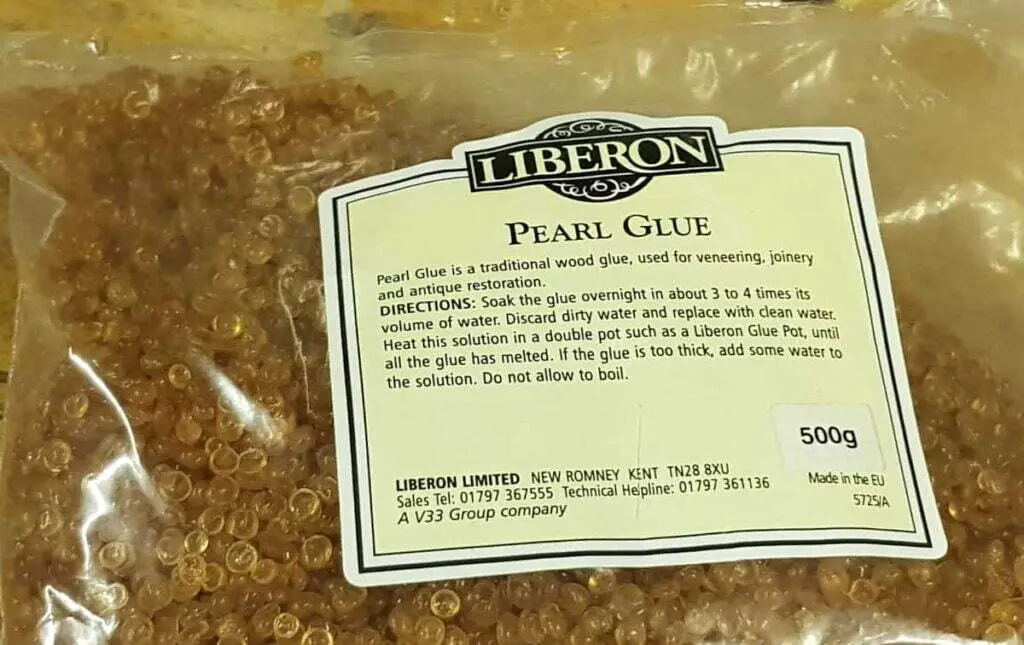
Animal Glues
Animal glues are protein colloid glue made from animals’ connective tissue. They have been used for thousands of years and offer a lot of benefits. Collagen is a protein found in skin, bone, and muscle, and is the primary ingredient in hide glues. This makes them ideal for repairing pottery and making paint.
This was used by old craftsmen and is still used for antique restoration. It has some unique advantages and disadvantages. A piece of damp fabric and clothes iron will reverse the bond, which makes it perfect for restoring antique furniture. If you will use it regularly, it needs a dedicated electric glue pot.
The Tang Dynasty also employed animal hide glue to bind and preserve pigment particles. You can purchase this natural glue in pearl or liquid form, and it’s easy to use.
Formaldehydes
I won’t go into much detail about these because they are industrial. Tooling loses its sharpness because of the Urea in sheet products, plywood, MDF, etc.
The Phenol group made Bakalight plastics, now on high-quality sheet products for jigs.
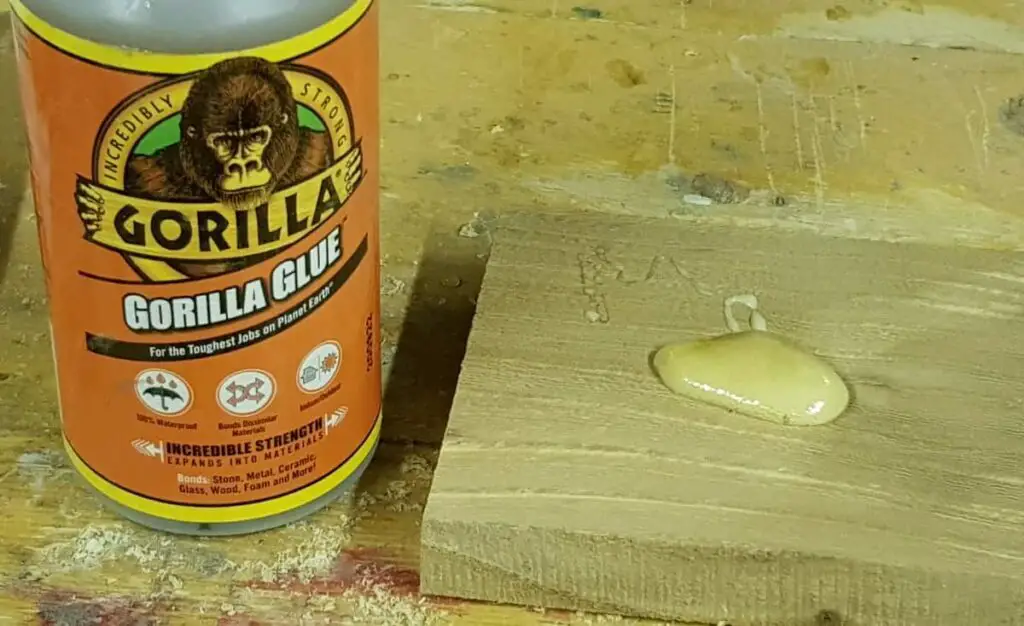
Polyurethane Glue (PU)
It is a synthetic rubber resin that binds objects well. Polyurethane is an all-purpose waterproof wood glue that reacts quickly with moisture to form a hard fixture.
For applications that demand sturdiness and longevity, the cured glue is robust. A popular choice for exterior work, it does not shrink or warp, is resistant to hot and cold, and doesn’t absorb moisture.
Versatile for many substrates, it is sandable once dried. If keyed correctly, it can be used on porous material, concrete, metal, plastics, stone and glass.
Both polyurethane and PVA glue are permanent. They are both polymer-based and can be used to permanently bind an assortment of materials together. Polyurethane has a PSI rating of around 3500, while Titebond’s exterior-grade glue has the strongest bond, failing at 3,750 PSI. Both kinds dry quickly and require temperature to set properly.
Polyurethane is an all-substance glue, unlike PVA glue, which is only used on wood materials. Its superior water resistance means this glue is ideal for outdoor use like decking.
Suggestion: Turn the bottle upside down for storage. Always wear protective clothing and gloves before starting work with this, or you will have dirty, dark hands for days. Please don’t ask how I know 🙄.
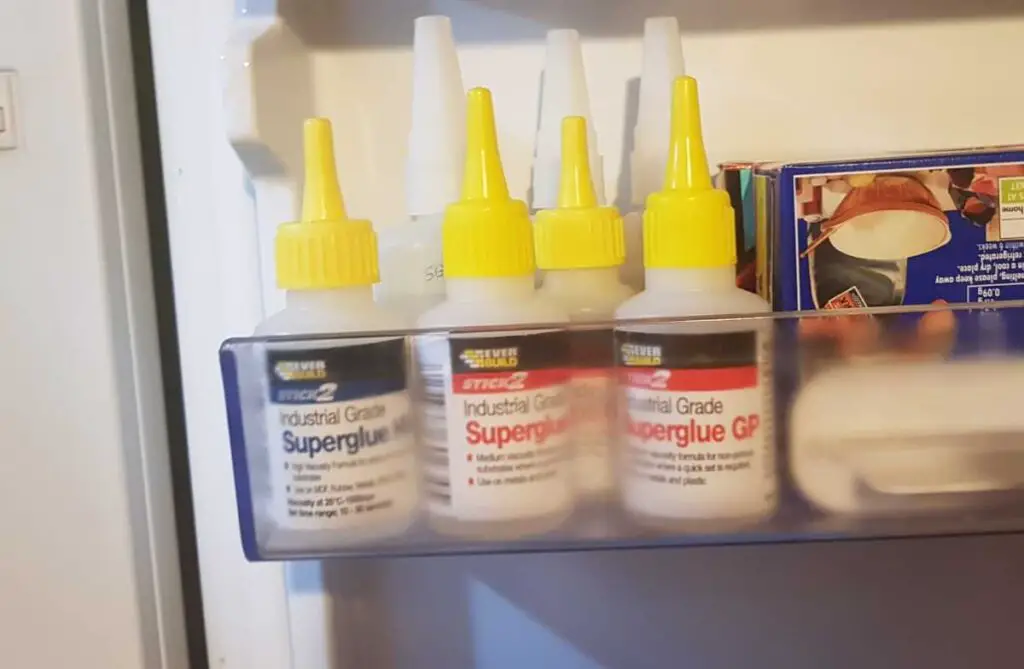
Cyanoacrylate (CA)
CA is a quick-drying acrylic resin—and another name for cyanoacrylate super glue. This powerful, fast-acting glue attaches instantly (45-second working time) to most surfaces without clamping. It is popular in DIY woodworking, crafts, model making, and repairs. The thin kind soaks into the wood fast if you need to stabilize it. Superglue has also been used in medicine to stick tissues together during surgery.
The ones we are interested in are methyl 2-cyanoacrylate and ethyl-2-cyanoacrylate. Now available in thick, medium, and thin viscosities, with some colored. However, they are less versatile than PVA glues and should only be used when necessary. Ca glue is rarely employed on plastics, eating through some.
There is a big difference between brands and the fumes they give off. Some have a very irritating odour and need ventilation when using them.
Advice: You can find proprietary de-bonder or nail polish works though it is weaker. If you use lots, an investment in a bottle of acetone is cheaper and wise for cleaning up when it spills.
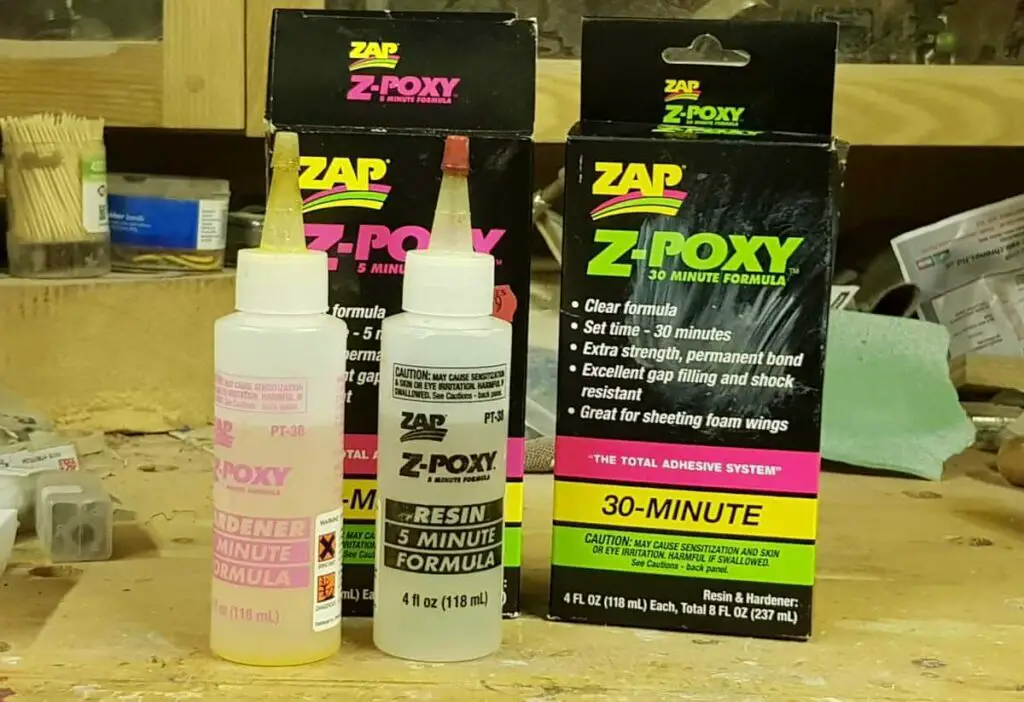
Epoxy glue
Epoxy wood glue is known for its strength and versatility. Often used in woodwork, metalworking, and other areas for a high bond strength. When its two components are combined, they produce a secure chemical bond.
When mixed, it forms a chemical reaction that creates heat and solidifies to fill tiny gaps and cracks. When properly applied, it can create a stronger bond than the wood or metal being joined. It sticks to most surfaces, so it is perfect for wood furniture repair, heavy-duty projects or large surfaces subject to high stress. Epoxies will dry clear and come in liquid and putty varieties, so they can be easily applied with a brush or spatula.
It can bond to wood, metals, ceramic, glass, and plastic, to name a few. It is resistant to water, heat, and chemicals, making it suitable for various environments.
Using epoxy is straightforward, but heed the manufacturer’s directions for optimum results. The first step is to mix them according to the directions provided.
It is essential to work quickly when using epoxies, as it begins to set within a few minutes of mixing. Once the glue has been applied, the wood will need 30 minutes of clamp time or held in place until the glue cures. Depending on the epoxy brand, this can take five minutes or overnight. If Zap z-poxy is not enough and you need a larger amount, try West system epoxy.
Tip: If it’s a cold day or thick in the bottle, put it near a heater for half an hour to thin it out. Ensure the heater is on 👍.
How to Choose the Best Glue For Wood
When choosing the best wood glue types, consider the type of wood, the object’s weight, and the environment. Do your homework to select a heavy duty wood glue for your task. PVA glue is the most prevalent and widely available.
When it comes to cabinetmaking, the right glue type can make all the difference. Choosing the correct sort depends on its chemical makeup and bonding agent. Glue has varying thicknesses, which can enhance a pleasing aesthetic effect.
But not all woodworking glues are equal- some are better for specific applications than others. When choosing the best wood adhesive, consider what you want to hold together and how long you want it to last. There are many sorts available, so there’s no need to settle for anything less than perfect.
Most glues need clamps, available online or at nearby hardware stores.
Glue Viscosity
High-viscosity glues are harder to apply, whereas low-viscosity glues are quicker. It is best to use glue with a viscosity that is as close as possible to the density of the wood itself. This will help ensure the glue does not run out of the joint before it sets.
There is a difference between run out and squeeze out, though. For a good joint, use enough glue to get a little squeeze out along the length as clamps are tightened.
Some wood fibers are more absorbent than others. For porous wood, you may need to size the end grain or use a more viscous glue to keep it from flowing out of the joints.
Six Tips for Using Wood Glue Effectively
When gluing wood, keeping a few things in mind is important.
- The shelf life of white glue is 24 months, so make sure you use it up before it expires.
- If you want to stop the nozzle from clogging, wipe it after application.
- Polyurethane, epoxy and superglue need to be handled with gloves.
- Always wear safety goggles when using glue–it can get into your eyes.
- If working with oily exotic woods, glue wood straight from machining. When joints have been left overnight, wipe them with Isopropyl alcohol to remove the surface oil.
- Even if you’re familiar with power tools, don’t let it lure you into thinking you can forgo tasks that require manual labour.
Which Are The Best Wood Glues?
There are many top rated wood glues on the market, and it can be difficult to decide which one is right for you. We’ve compiled a list of the best glues available today.
Titebond II 5005 Premium Wood Glue is our top suggestion. This glue is excellent for budget-conscious DIYers who need their job done ASAP and can be kept anywhere! It’s non-toxic and safe for incidental food contact, so it’s OK to use on kitchen goods. It has great tack and is water-resistant, making it ideal for use inside or outdoors.
If you’re looking for a more heavy-duty option that doesn’t dry out sensitive wood, we recommend the Gorilla Wood Glue. This adhesive strength has a super strong bond that will hold up even under extreme conditions. It can be used outdoors in rain or snow without issue; it comes with a higher price tag than others we listed.
Elmer’s Wood Glue is best if you are on a tight budget. It has a decent cure time and comes in a large gallon jug for an unbeatable price. Since it offers no protection from the elements, it should not be used in outdoor applications.
We hope the next part will help you choose the best for your needs!
1. 16 oz Bottle, Titebond II Premium Wood Glue

Titebond glue is an excellent choice for high quality wood glue. This premium glue bonds well for outdoor furniture construction and interior DIY projects. A weatherproof wood adhesive, it is quick to apply and is for all kinds of wood.
The fast-drying, moisture-resistant glue is formulated for professional woodworkers. It performs well in many situations and guarantees bond integrity. As an added bonus, it’s much cheaper than others.
Pros:
2. Titebond lll Ultimate Wood Glue (16fl oz)

Titebond Ultimate wood glue is user-friendly and has a good initial grab. It also has Type-1 water resistance, making it suitable for indoor and outdoor project use. Being food-safe, this popular wood glue option may be worth the extra expense.
Pros:
3. Liquid Hide Glue 4 oz / 8 oz
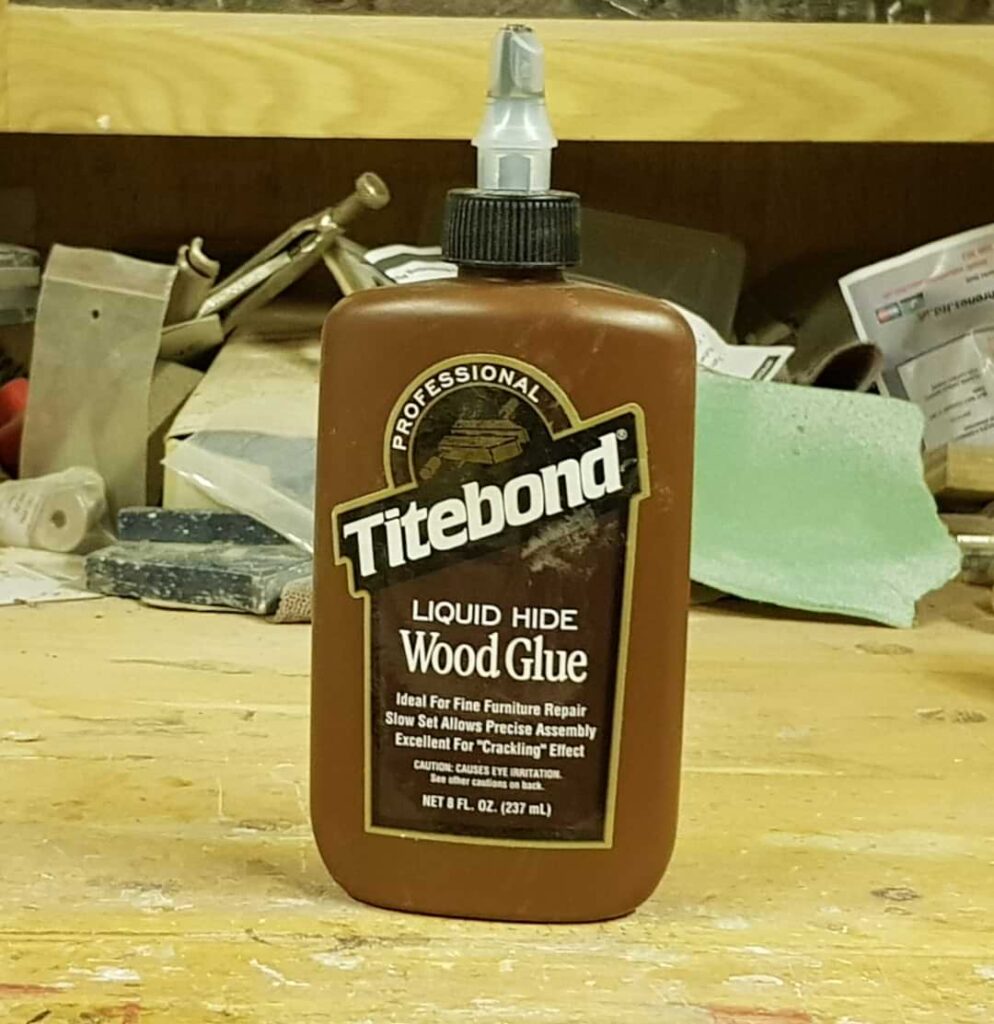
Titebond genuine hide glue offers a lengthy working window, allowing you long enough to get the job done right. This genuine hide glue also has an extended open time, allowing you to make adjustments. It bonds securely to a variety of substrates and provides a strong initial tack.
It also has excellent sandability and a fast dry time, matching the color of the wood. The liquid formula makes it easier to use than traditional glue, which needs to stand and soak overnight before use. Because it dries a natural color, it’s also great for invisible repairs. It can also create an attractive aged crackle look on dry and sanded surfaces, so is suitable for antique furniture repair.
Traditional hide glue is a great choice and ecologically friendly for long-lasting, reversible furniture repairs.
4. Gorilla Original Waterproof Polyurethane Glue, 8 Ounce Bottle

Gorilla original polyurethane wood glue is stronger than wood due to its ability to bond materials like metal, ceramic, concrete and more. Offering flexibility and water resistance in diverse environments. No mixing is required with Gorilla glue; spread it directly onto both surfaces. Polyurethane glue expands with moisture, so the wood must be slightly damp before application.
While setting, Gorilla wood glue penetrates deep into the wood grain, ensuring robust joinery. The expanding qualities are not structural; it has a honeycomb-like structure. This general purpose glue is suitable for outdoor applications.
5. Starbond 2 oz Medium Super Glue
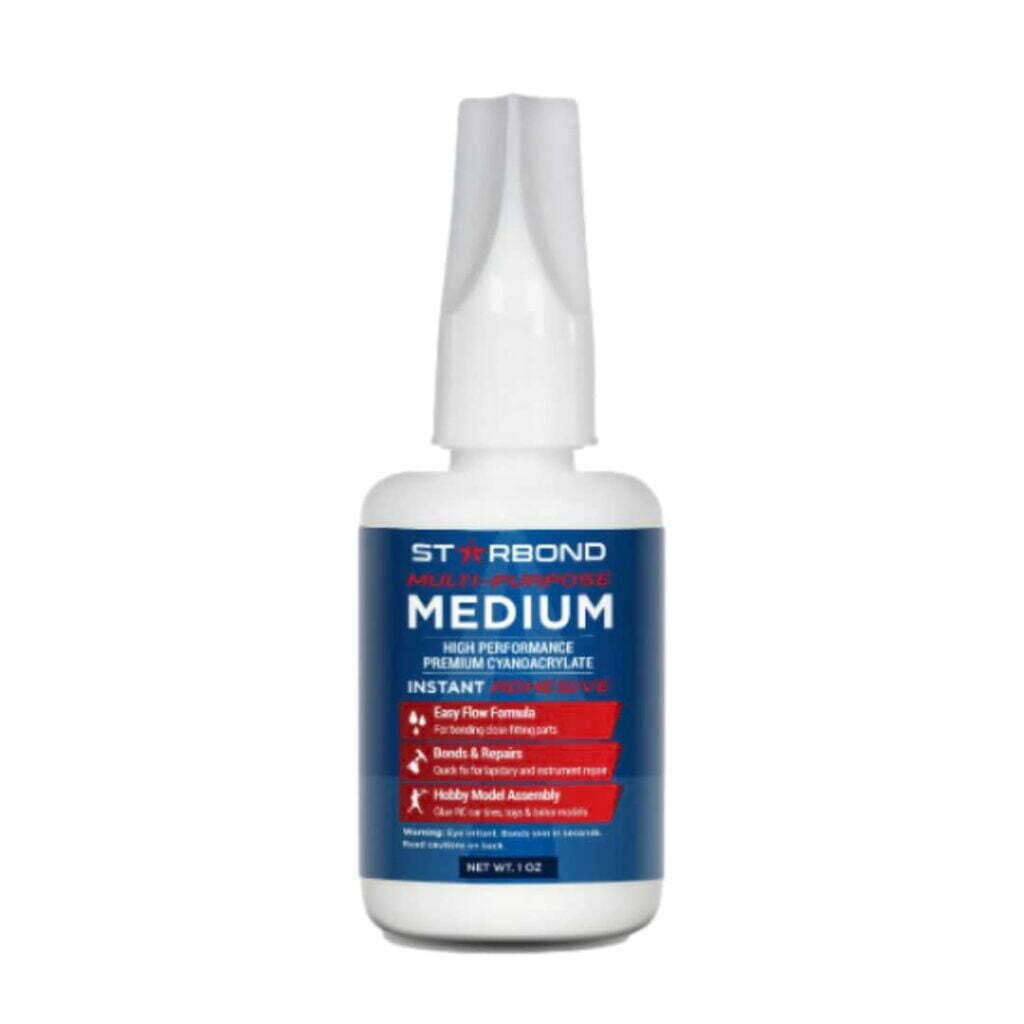
Starbond super glue sets fast and adheres so strongly that it’s often hard to separate wood pieces. Its composition quickly wicks and penetrates the wood. This makes it handy when speed is essential or when you must rapidly apply large amounts.
6. Polyvine Cascamite Wood Glue 500G
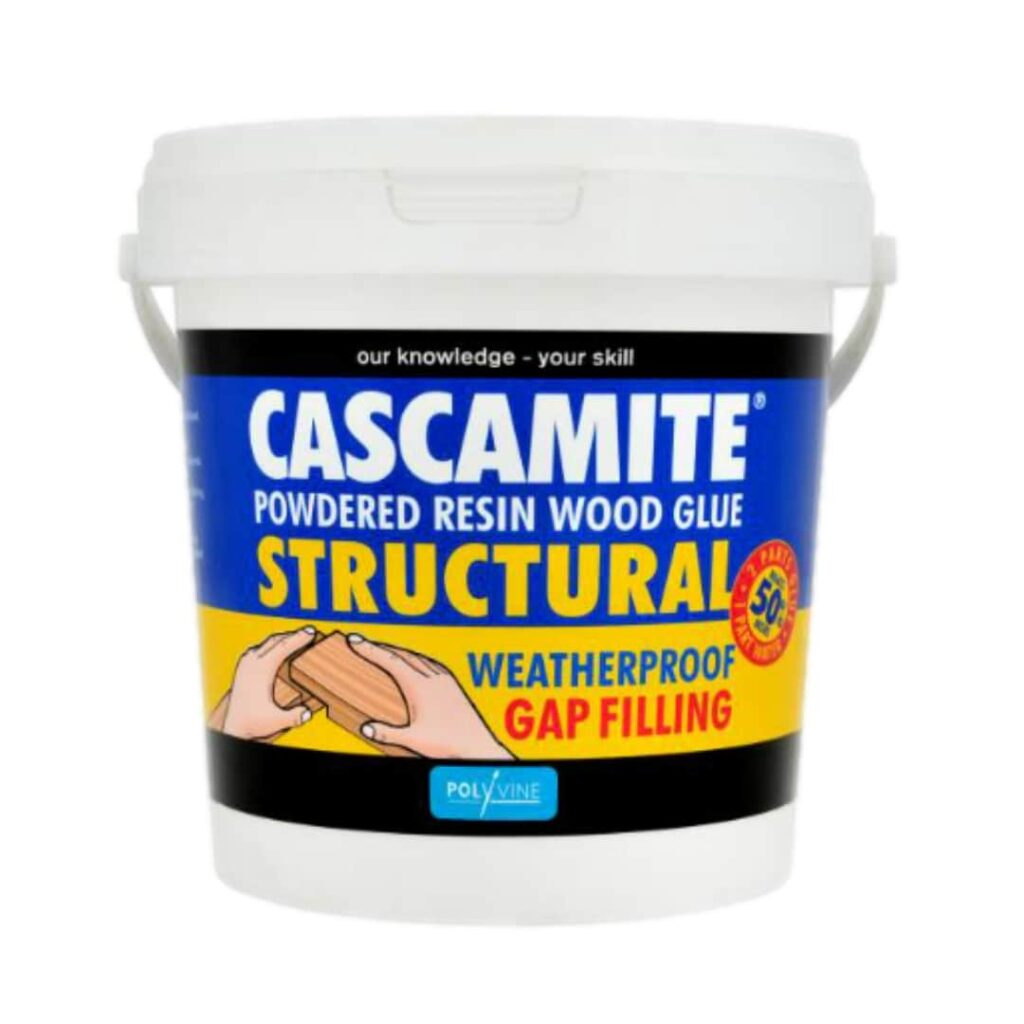
Cascamite offers unique benefits that are excellent for home improvement projects. This watertight glue will remain strong even in warm weather without shrinkage. Upon drying, the binding formed by this very strong wood glue is even tougher than the wood itself.
Structural gap filling capabilities and the joint can be machined when dry. Simple to apply, only needing application on one surface. Well-suited for internal or external joinery, shopfitting, and veneering. Cascamite glue dries fast at the correct temperature so you can return to work.
Pros
- All weather conditions.
- Strong bond.
Cons
- Vulnerable to temperature.
- Tough to mix correctly.
7. Zap Z- Poxy 30 min Epoxy
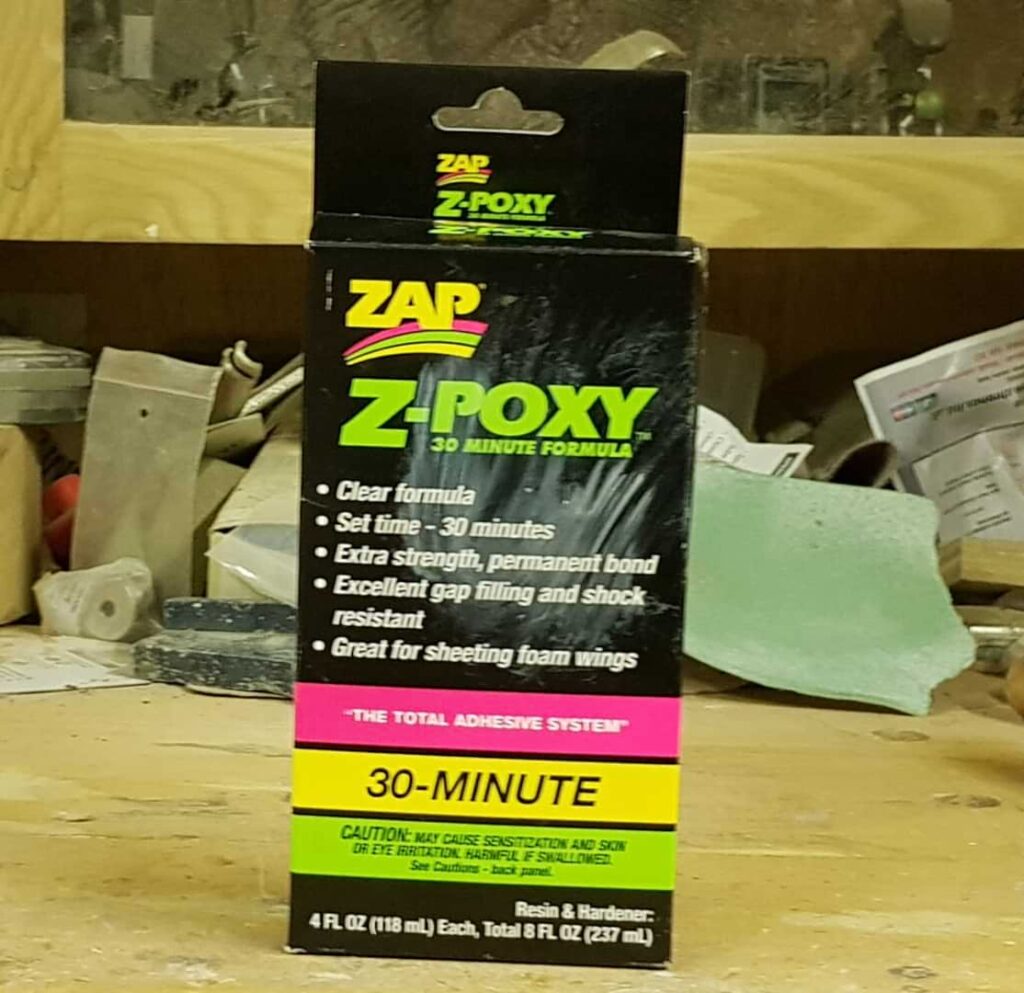
The high-strength formula in Zap Z- Poxy gives this product its strong glue properties. This two-part resin and hardener provide superior adhesion, holding wood together firmly. This glue’s water-resistance and weatherproof qualities allow it to withstand harsh, humid conditions.
After application, Zap Z- Poxy can be sanded and painted for a finished look. The convenience and adaptability make it ideal for any wood project.
Pros
- Straightforward to use.
- Shockproof.
- Uses for a range of carpentry projects.
- Resists fuel, oil, solvents and many chemicals.
Cons
- Affected by temperature and humidity.
8. Pack of 50 Black Hot Glue Sticks

Hot melt glue is a thermoplastic that becomes tacky when heated and bonds materials such as wood, card, plastic and more. Typically used for small projects such as making jigs or lathe faceplate jobs. It can fill gaps in wood or other materials. Glue guns come in various sizes for maximum precision with small or large pieces of wood.
9. Liberon Pearl Glue
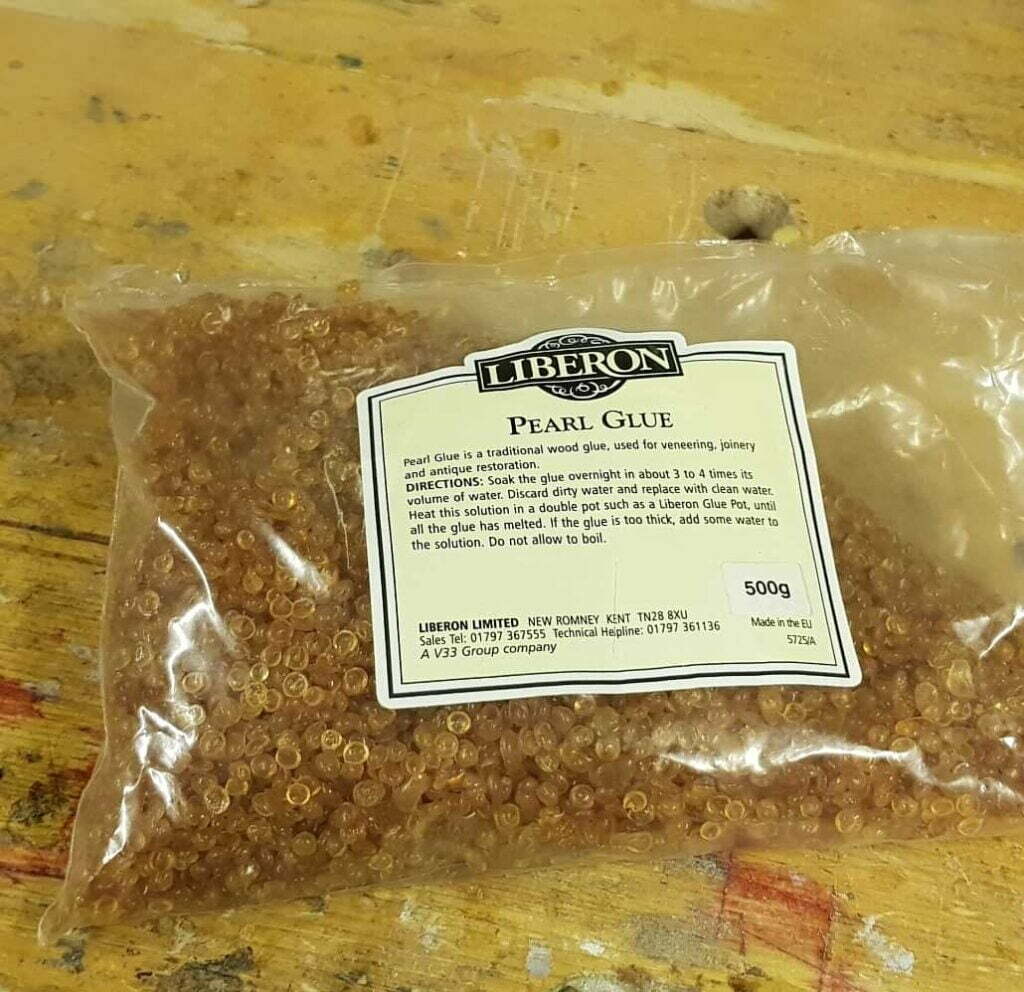
Pearl Glue is a high-quality, water-based adhesive for wooden furniture. Restorers like it because of its bonding strength and other advantages. Perfect for laying figured veneer; if any leeches through, it will stain. Another benefit, this natural wood glue is non-toxic, making it environmentally safe to use. It dries clear and is handy when a visible glue line is not desired.
Pros
- Easy to apply and precise control.
Cons
- Really needs an electrically heated pot.
How to clean up wood glue
Clean wet glue with water and a cloth to wipe away excess PVA glue or cascamite glue, don’t try to clean the others until dry. If the glue is dry, it can be scraped off with a chisel plane or a card scraper after it has cured.
When using glue, cleaning up any messes quickly is important. If you allow the glue to dry, cleanup can be difficult (sometimes impossible). Here are a few tips to remove glue:
- If polyurethane has cured, dissolve it with mineral spirits or turpentine. Study the label carefully before using any solvents, as some can be harmful if inhaled.
- Heat epoxy slowly with a hair dryer, but be careful not to damage the surrounding area. A low setting of the hair dryer should be sufficient.
- To loosen things up, point the hair dryer at it from a distance of 20 cm for a few minutes. Now and again, check to see if it is ready for removal with a paper towel or cabinet scraper if needed.
- Sprinkle a lint-free cloth generously with acetone and rub over ca glue; it works but is slow progress.
- If all else fails, you may have to sand the surface of the wood to remove dried glue.
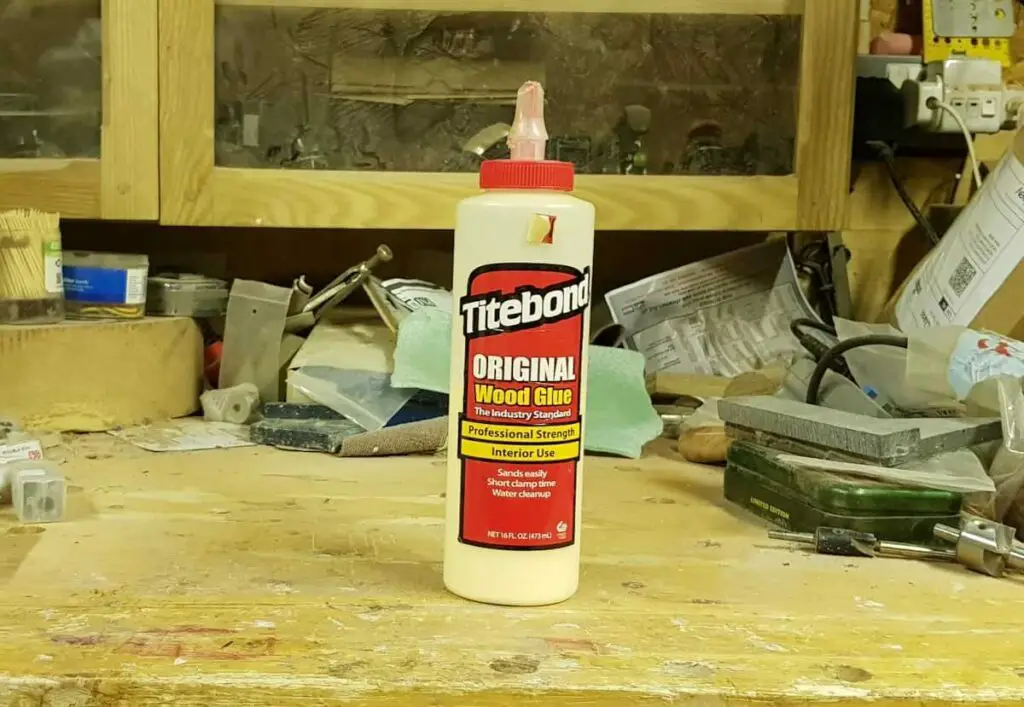
Are wood glue and carpenter’s glue the same?
Though they serve similar purposes, wood glue and carpenters’ wood glue are not the same. Standard wood glue, also known as woodworking glue or PVA glue, is designed for woodworking projects. It is typically water-based and known for its strong bonding and ease of use. Besides the obvious of joining wood to wood, it also fills in small gaps in the wood.
On the other hand, carpenter’s wood glue is a catch-all name that can refer to any glue carpenters use. This may include woodglue and other adhesives such as polyurethane or epoxy.
What is the best glue for you?
The best wood glue for your project will depend on the requirements and the components. Consider how to apply the glue, tropical hardwood or softwood, and consult the instructions for a robust and durable bond.

